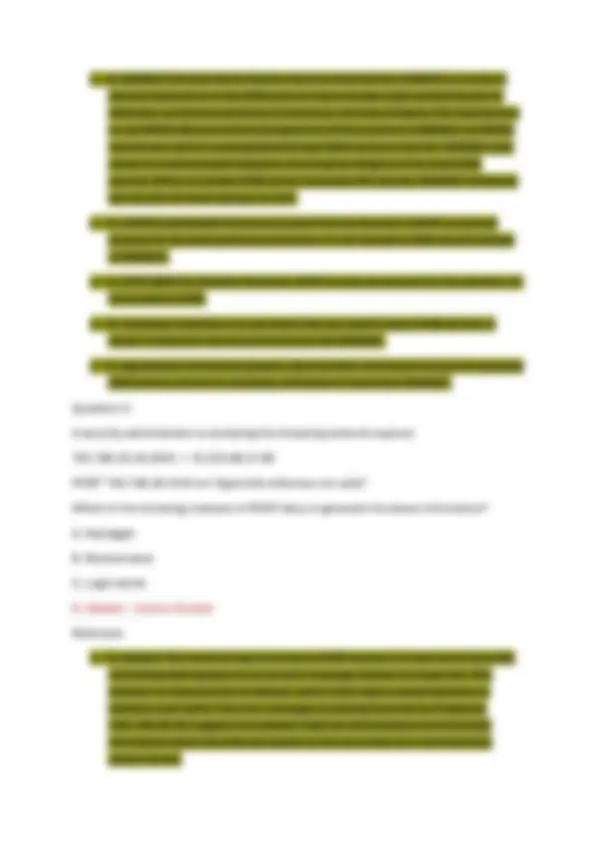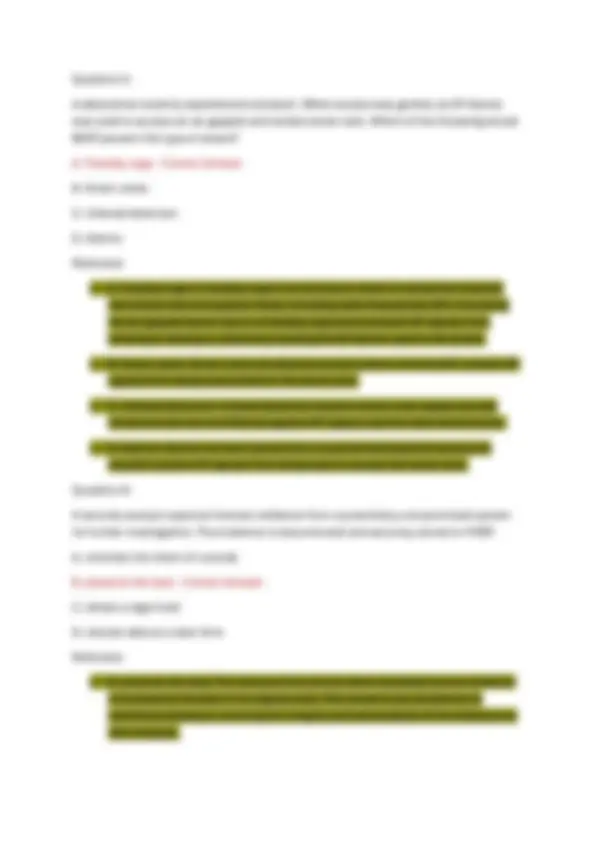

























Study with the several resources on Docsity

Earn points by helping other students or get them with a premium plan


Prepare for your exams
Study with the several resources on Docsity

Earn points to download
Earn points by helping other students or get them with a premium plan
Community
Ask the community for help and clear up your study doubts
Discover the best universities in your country according to Docsity users
Free resources
Download our free guides on studying techniques, anxiety management strategies, and thesis advice from Docsity tutors
CompTIA Security+ SY0-701 Exam Study Guide 2025: Complete Certification Prep with Core Concepts, Real-World Cybersecurity Examples, and Expert Practice Questions
Typology: Exams
1 / 31

This page cannot be seen from the preview
Don't miss anything!
























Here are the multiple-choice questions with rationales and the correct answers indicated: Question 1: A company has three divisions, each with its own networks and services. The company decides to make its secure web portal accessible to all employees utilizing their existing usernames and passwords. The security administrator has elected to use SAML to support authentication. In this scenario, which of the following will occur when users try to authenticate to the portal? (Select two) A. The portal will function as a service provider and request an authentication assertion
Question 5: A datacenter recently experienced a breach. When access was gained, an RF device was used to access an air-gapped and locked server rack. Which of the following would BEST prevent this type of attack? A. Faraday cage - Correct Answer B. Smart cards C. infrared detection D. Alarms Rationale:
A security administrator receives an alert from a third-party vendor that indicates a certificate that was installed in the browser has been hijacked at the root of a small public C The security administrator knows there are at least four different browsers in use on more than a thousand computers in the domain worldwide. Which of the following solutions would be BEST for the security administrator to implement to most efficiently assist with this issue? A. SSL B. CRL - Correct Answer C. PKI D. ACL Rationale:
B. Enterprise C. WiFi Protected Setup D. Captive portal - Correct Answer Rationale:
then rm - rf/ fi Based on the above information, which of the following types of malware was installed on the server /local/? A. Logic bomb B. Trojan C. Backdoor D. Ransomware E. Rootkit - - correct ans- - C In terms of encrypting data, which of the following is BEST described as a way to safeguard password data by adding random data to it in storage? A. Using salt B. Using hash algorithms C. Implementing elliptical curve D. Implementing PKI - - correct ans- - A A system administrator wants to provide for and enforce wireless access accountability during events where external speakers are invited to make presentations to a mixed audience of employees and non-employees. Which of the following should the administrator implement? A. Shared accounts B. Preshared passwords C. Least privilege D. Sponsored guest - - correct ans- - D
Which of the following would MOST likely appear in an uncredentialed vulnerability scan? A. Self-signed certificates B. Missing patches C. Auditing parameters D. Inactive local accounts - - correct ans- - D When identifying a company's most valuable assets as part of a BIA, which of the following should be the FIRST priority? A. Life B. Intellectual property C. Sensitive data D. Public reputation - - correct ans- - A An organization needs to implement a large PKI. Network engineers are concerned that repeated transmission of the OCSP will impact network performance. Which of the following should the security analyst recommend in lieu of an OCSP? A. CSR B. CRL C. CA D. OID - - correct ans- - B When considering a third-party cloud service provider, which of the following criteria would be the BEST to include in the security assessment process? (Select two)
An organization's file server has been virtualized to reduce costs. Which of the following types of backups would be MOST appropriate for the particular file server? A. Snapshot B. Full C. Incremental D. Differential - - correct ans- - C A wireless network uses a RADIUS server that is connected to an authenticator, which in turn connects to a supplicant. Which of the following represents the authentication architecture in use? A. Open systems authentication B. Captive portal C. RADIUS federation D. 802.1x - - correct ans- - D An employer requires that employees use a key-generating app on their smartphones to log into corporate applications. In terms of authentication of an individual, this type of access policy is BEST defined as: A. Something you have B. Something you know C. Something you do D. Something you are - - correct ans- - A Adhering to a layered security approach, a controlled access facility employs security guards who verify the authorization of all personnel entering the facility. Which of the following terms BEST describes the security control being employed?
A. Administrative B. Corrective C. Deterrent D. Compensating - - correct ans- - A A security analyst is hardening a web server, which should allow a secure certificate- based session using the organization's PKI infrastructure. The web server should also utilize the latest security techniques and standards. Given this set of requirements, which of the following techniques should the analyst implement to BEST meet these requirements? (Select two) A. Install an X- 509 - compliant certificate B. Implement a CRL using an authorized CA C. Enable and configure TLS on the server D. Install a certificate signed by a public CA E. Configure the web server to use a host header - - correct ans- - AC A manager wants to distribute a report to several other managers within the company. Some of them reside in remote locations that are not connected to the domain but have a local server. Beacuse there is sensitive data within the report and the size of the report is beyond the limit of the email attachment size, emailing the report is not an option. Which of the following protocols should be implemented to distribute the report securely? (Select three) A. S/MIME B. SSH C. SNMPv D. FTPS E. SRTP F. HTTPS G. LDAPS - - correct ans- - BDF
D. Passive scan - - correct ans- - A Which of the following cryptography algorithms will produce a fixed-length, irreversible output? A. AES B. 3DES C. RSA D. MD5 - - correct ans- - D A technician suspects that a system has been compromised. The technician reviews the following log entry: WARNING- hash mismatch: C:\Window\SysWOW64\user32.dll WARNING- hash mismatch: C:\Window\SysWOW64\kernel32.dll Based solely on the information above, which of the following types of malware is MOST likely installed on the system? A. Rootkit B. Ransomware C. Trojan D. Backdoor - - correct ans- - A A new firewall has been placed into service at an organization. However, a configuration has not been entered on the firewall. Employees on the network segment covered by the new firewall report are unable to access the network. Which of the following steps should be completed to BEST resolve the issue? A. The firewall should be configured to prevent user traffic from matching the implicit deny rule
B. The firewall should be configured with access lists to allow inbound and outbound traffic C. The firewall should be configured with port security to allow traffic D. The firewall should be configured to include an explicit deny rule - - correct ans- - A A security analyst is testing both Windows and Linux systems for unauthorized DNS zone transfers within a LAN on comptia.org from example.org. Which of the following commands should the security analyst use? (Select two) A. nslookupcomptia.orgset type=ANYIs-d example.org B. nslookupcomptia.orgset type=MXexample.org C. dig - axfr comptia.org@example.org D. ipconfig/flushDNS E. ifconfig eth0 downifconfig eth0 updhclient renew F. dig@example.org comptia.org - - correct ans- - AC Which of the following are the MAIN reasons why a systems administrator would install security patches in a staging environment before the patches are applied to the production server? (Select two) A. To prevent server availability issues B. To verify the appropriate patch is being installed C. To generate a new baseline hatch after patching D. To allow users to test functionality E. To ensure users are trained on new functionality - - correct ans- - AD A Chief Information Officer drafts an agreement between the organization and its employees. The agreement outlines ramifications for releasing information without consent and/for approvals. Which of the following BEST describes this type of agreement?
D. Enable an SSL certificate for IMAP services - - correct ans- - D Before an infection was detected, several of the infected devices attempted to access a URL that was similar to the company name but with two letters transported. Which of the following BEST describes the attack vector used to infect the devices? A. Cross-site scripting B. DNS poisoning C. Typo squatting D. URL hijacking - - correct ans- - C Joe, a security administrator, needs to extend the organization's remote access functionality to be used by staff while traveling. Joe needs to maintain separate access control functionalities for internal, external, and VOIP services. Which of the following represents the BEST access technology for Joe to use? A. RADIUS B. TACACS+ C. Diameter D. Kerberos - - correct ans- - B The availability of a system has been labeled as the highest priority. Which of the following should be focused on the MOST to ensure the objective? A. Authentication B. HVAC C. Full-disk encryption D. File integrity checking - - correct ans- - B
As part of the SDLC, a third party is hired to perform a penetration test. The third party will have access to the source code, integration tests, and network diagrams. Which of the following BEST describes the assessment being performed? A. Black box B. Regression C. White box D. Fuzzing - - correct ans- - C A dumpster diver recovers several hard drives from a company and is able to obtain confidential data from one of the hard drives. The company then discovers its information is posted online. Which of the following methods would have MOST likely prevented the data from being exposed? A. Removing the hard drive from its enclosure B. Using software to repeatedly rewrite over the disk space C. Using Blowfish encryption on the hard drives D. Using magnetic fields to erase the data - - correct ans- - D Which of the following are methods to implement HA in a web application server environment? (Select two) A. Load balancers B. Application layer firewalls C. Reverse proxies D. VPN concentrators E. Routers - - correct ans- - AB